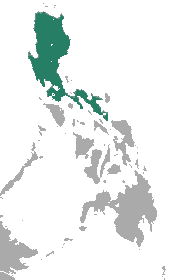
Megabats constitute the family Pteropodidae of the order Chiroptera (bats). They are also called fruit bats, Old World fruit bats, or—especially the genera Acerodon and Pteropus—flying foxes. They are the only member of the superfamily Pteropodoidea, which is one of two superfamilies in the suborder Yinpterochiroptera. Internal divisions of Pteropodidae have varied since subfamilies were first proposed in 1917. From three subfamilies in the 1917 classification, six are now recognized, along with various tribes. As of 2018, 197 species of megabat had been described.

The giant golden-crowned flying fox, also known as the golden-capped fruit bat, is a species of megabat endemic to the Philippines. Since its description in 1831, three subspecies of the giant golden-crowned flying fox have been recognized, one of which is extinct. The extinct subspecies was formerly recognized as a full species, the Panay golden-crowned flying fox. Formerly, this species was placed in the genus Pteropus; while it is no longer within the genus, it has many physical similarities to Pteropus megabats. It is one of the largest bat species in the world, weighing up to 1.4 kg (3.1 lb)—only the Indian and great flying fox can weigh more. It has the longest documented forearm length of any bat species at 21 cm (8.3 in).

The Egyptian fruit bat or Egyptian rousette is a species of megabat that occurs in Africa, the Middle East, the Mediterranean and the Indian subcontinent. It is one of three Rousettus species with an African-Malagasy range, though the only species of its genus found on continental Africa. The common ancestor of the three species colonized the region in the late Pliocene or early Pleistocene. The species is traditionally divided into six subspecies. It is considered a medium-sized megabat, with adults weighing 80–170 g (2.8–6.0 oz) and possessing wingspans of approximately 60 cm (24 in). Individuals are dark brown or grayish brown, with their undersides paler than their backs.

The spotted-winged fruit bat is the smallest megabat in the world. It inhabits forests in Brunei, Indonesia, Malaysia, and Thailand.

The long-tongued nectar bat, also known as the northern blossom bat, honey nectar bat, least blossom-bat, dagger-toothed long-nosed fruit bat, and lesser long-tongued fruit bat, is a species of megabat. M. minimus is one of the smallest species in the family Pteropodidae, with an average length of 60–85 mm. It has a reddish-brown colouring with relatively long hair compared to the other species. The hair on the abdomen is a lighter colour, and a dark brown stripe runs bilaterally down the top of the head and back.
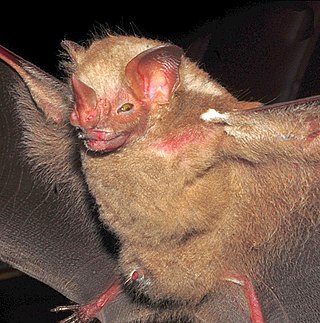
The Ipanema bat is a bat species of order Chiroptera and family Phyllostomidae. It is found in northern Argentina, Bolivia, southeastern Brazil and Paraguay. It is the only species within its genus.

Livingstone's fruit bat, also called the Comoro flying fox, is a megabat in the genus Pteropus. It is an Old World fruit bat found only in the Anjouan and Mohéli islands in the Union of the Comoros in the western Indian Ocean.

The Mindanao pygmy fruit bat is a species of megabat in the family Pteropodidae. It is the only species within the genus Alionycteris. It is endemic to the Philippines. Its natural habitat is subtropical or tropical dry forests at high elevations that are either scarce or overtaken by tourist hotspots. As a result, this species may be seeking new elevated habitats likely in the southern region of the Philippines and along the islands of Sulawesi.

Wahlberg's epauletted fruit bat is a species of megabat in the family Pteropodidae. It is commonly found across southern Africa.

Buettikofer's epauletted fruit bat is a species of megabat in the family Pteropodidae. It is found in Ivory Coast, Ghana, Guinea, Guinea-Bissau, Liberia, Nigeria, Senegal, and Sierra Leone. Its natural habitats are subtropical or tropical moist lowland forest and savanna.

The harpy fruit bat is a species of megabat in the family Pteropodidae. It is endemic to the Philippines.
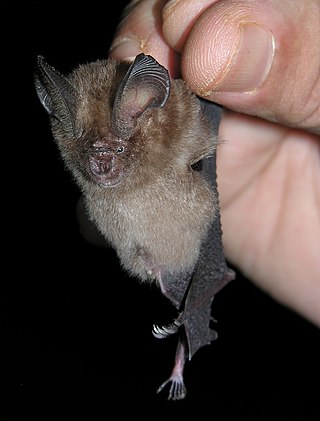
The dusky leaf-nosed bat is a bat from the genus Hipposideros whose habitat extends from India and Sri Lanka to the Philippines, New Guinea and Northern Australia. This species is counted in the H. bicolor species group and was formerly classified within that species.
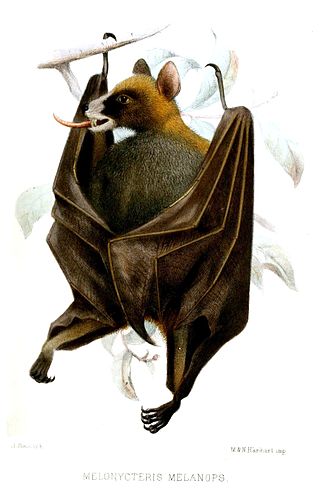
The black-bellied fruit bat is a species of order bat in the family Pteropodidae.

Peters's dwarf epauletted fruit bat is a species of megabat in the family Pteropodidae. It is found in Angola, Benin, Burkina Faso, Burundi, Cameroon, Central African Republic, Chad, Republic of the Congo, Democratic Republic of the Congo, Ivory Coast, Equatorial Guinea, Ethiopia, Gabon, Gambia, Ghana, Guinea, Guinea-Bissau, Kenya, Liberia, Mali, Niger, Nigeria, Rwanda, Senegal, Sierra Leone, Sudan, Tanzania, Togo, Uganda, and Zambia. Its natural habitats are subtropical or tropical moist lowland forests and moist savanna.

The demonic tube-nosed fruit bat is a species of bat in the family Pteropodidae. It is endemic to Papua New Guinea. The holotype specimen was collected in 1979 on New Ireland, in the Bismarck Archipelago. It was described as a new species in 1983. The range of the species may extend to other islands, however the extent of the range is not presently known.

The Fijian monkey-faced bat, also known as the Fijian flying fox or Fijian flying monkey, is a megabat endemic to Fiji. It was discovered in old-growth cloud forest on Des Vœux Peak, the second highest mountain peak on the island of Taveuni by William and Ruth Beckon in 1976, and is Fiji's only endemic mammal. It has recently been transferred from Pteralopex to its own monotypic genus Mirimiri.
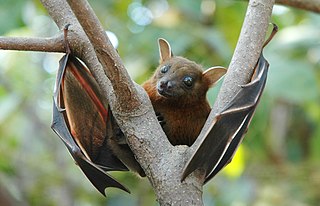
The lesser short-nosed fruit bat is a species of megabat within the family Pteropodidae. It is a small bat that lives in South Asia and Southeast Asia. It weighs between 21 and 32 grams, and measures 70 to 127 millimetres. It occurs in many types of habitat, but most frequently in disturbed forest, including lower montane forest and tropical lowland rain forest, plus gardens, mangroves, and vegetation on beaches.

Nyctimene is a genus of bats in the Pteropodidae family. Commonly known as tube-nosed fruit bats, they are found in the central Philippines, eastern Indonesia, Papua New Guinea and the north-east coast of Australia.
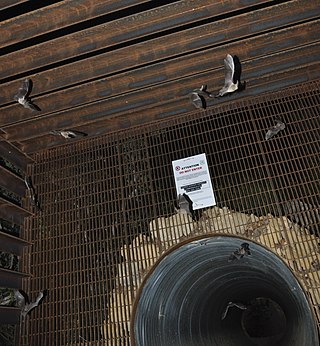
A maternity colony refers to a temporary association of reproductive female bats for giving birth to, nursing, and weaning their pups. The colonies are initiated by pregnant bats. After giving birth, the colony consists of the lactating females and their offspring. After weaning, juveniles will leave the maternity colony, and the colony itself will break apart. The size of a maternity colony is highly variable by species, with some species forming colonies consisting of ten or fewer individuals, while the largest maternity colony in the world in Bracken Cave is estimated to have over 15 million bats.
